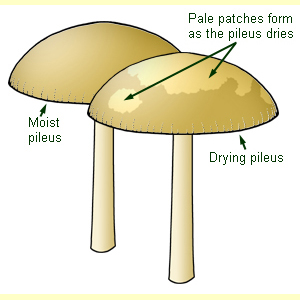
This feature must be observed on very fresh material in excellent condition. In dry, hot or windy conditions the surface of the pileus will rapidly and completely dry out and the hygrophanous nature of the pileus will no longer be visible. Other features that disappear on drying are a translucent-striate pileus or a viscid or glutinous pileus. If you suspect that the pileus has dried out, look around for fresher fruit-bodies under leaves or litter, or in other more protected microhabitats.
In order to observe this feature you must start with a fresh fruit-body and deliberately let it start to dry out. Sometimes this process will already have started in the field, producing a strikingly two-toned pileus.
Choose this state if: there is a distinct contrast in colour as the pileus dries between the dried and undried portions. Typically the middle of the pileus dries out first, leaving a paler centre, but sometimes the edge may dry first.
